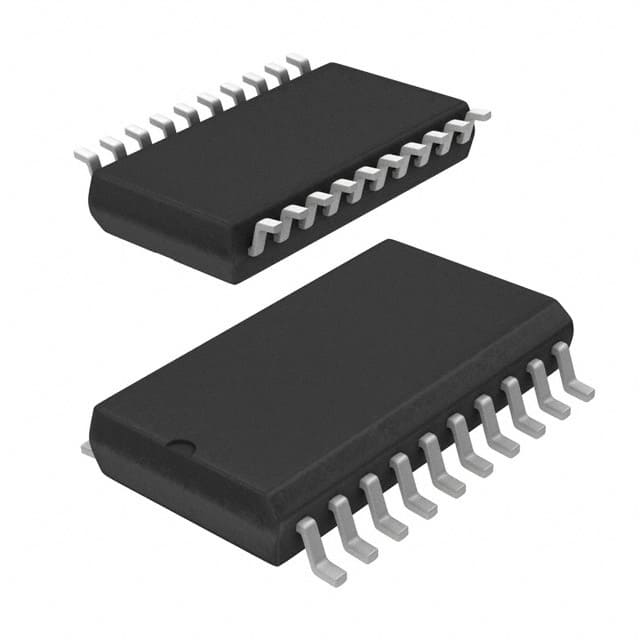Consulte las especificaciones para obtener detalles del producto.

AT89C1051-12SI
Product Overview
Category: Microcontroller
Use: Embedded Systems
Characteristics: Low-power, high-performance 8-bit microcontroller
Package: 20-pin Small Outline Integrated Circuit (SOIC)
Essence: Control and process data in embedded systems
Packaging/Quantity: Available in reels of 2500 units
Specifications
- Operating Voltage: 2.7V to 6V
- Clock Frequency: 12 MHz
- Flash Memory: 1 KB
- RAM Size: 64 Bytes
- I/O Pins: 15
- Timers/Counters: 2
- Serial Communication: UART
Detailed Pin Configuration
The AT89C1051-12SI microcontroller has a total of 20 pins, each serving a specific purpose. The pin configuration is as follows:
- P1.0 - Port 1, Pin 0
- P1.1 - Port 1, Pin 1
- P1.2 - Port 1, Pin 2
- P1.3 - Port 1, Pin 3
- P1.4 - Port 1, Pin 4
- P1.5 - Port 1, Pin 5
- P1.6 - Port 1, Pin 6
- P1.7 - Port 1, Pin 7
- RST - Reset Pin
- XTAL1 - Crystal Oscillator Input
- XTAL2 - Crystal Oscillator Output
- GND - Ground
- P3.0/RXD - Port 3, Pin 0 / Serial Receive Data
- P3.1/TXD - Port 3, Pin 1 / Serial Transmit Data
- P3.2/INT0 - Port 3, Pin 2 / External Interrupt 0
- P3.3/INT1 - Port 3, Pin 3 / External Interrupt 1
- VCC - Supply Voltage
- EA/VPP - External Access Enable / Programming Voltage
- ALE/PROG - Address Latch Enable / Program Pulse
- PSEN - Program Store Enable
Functional Features
- Low-power consumption for energy-efficient applications
- High-performance 8-bit microcontroller suitable for embedded systems
- Flash memory allows for easy program updates
- UART enables serial communication with other devices
- Two timers/counters for precise timing operations
- External interrupt pins for event-driven programming
Advantages and Disadvantages
Advantages: - Low power consumption extends battery life in portable devices - Compact package size makes it suitable for space-constrained designs - Flash memory allows for easy firmware updates without replacing the chip - UART enables communication with a wide range of external devices - External interrupt pins provide flexibility for event-driven applications
Disadvantages: - Limited RAM size may restrict the complexity of programs - 8-bit architecture may not be sufficient for certain high-performance applications - Limited number of I/O pins may limit the connectivity options
Working Principles
The AT89C1051-12SI microcontroller operates based on an 8-bit architecture. It executes instructions stored in its flash memory to control and process data in embedded systems. The clock frequency determines the speed at which instructions are executed. The microcontroller communicates with other devices through its I/O pins and UART interface. It can also respond to external events using the interrupt pins.
Detailed Application Field Plans
The AT89C1051-12SI microcontroller finds applications in various fields, including but not limited to:
- Home Automation Systems
- Industrial Control Systems
- Automotive Electronics
- Medical Devices
- Consumer Electronics
Detailed and Complete Alternative Models
- AT89C2051-24PU: Similar microcontroller with 2 KB of flash memory and 128 bytes of RAM.
- AT89S52-24PU: Enhanced version with 8 KB of flash memory, 256 bytes of RAM, and additional features.
These alternative models offer increased memory capacity and additional features for more demanding applications.
Word count: 446 words
Enumere 10 preguntas y respuestas comunes relacionadas con la aplicación de AT89C1051-12SI en soluciones técnicas
Sure! Here are 10 common questions and answers related to the application of AT89C1051-12SI in technical solutions:
Q1: What is AT89C1051-12SI? A1: AT89C1051-12SI is a microcontroller from Atmel, which is widely used in various technical solutions.
Q2: What is the operating voltage range of AT89C1051-12SI? A2: The operating voltage range of AT89C1051-12SI is typically between 4.0V and 6.0V.
Q3: How much flash memory does AT89C1051-12SI have? A3: AT89C1051-12SI has 1 kilobyte (KB) of flash memory.
Q4: Can I use AT89C1051-12SI for real-time applications? A4: Yes, AT89C1051-12SI can be used for real-time applications as it has an on-chip oscillator that provides accurate timing.
Q5: Does AT89C1051-12SI support serial communication? A5: Yes, AT89C1051-12SI supports serial communication through its UART (Universal Asynchronous Receiver/Transmitter) interface.
Q6: What is the maximum clock frequency of AT89C1051-12SI? A6: The maximum clock frequency of AT89C1051-12SI is 12 MHz.
Q7: Can I use AT89C1051-12SI for low-power applications? A7: Yes, AT89C1051-12SI has power-saving modes and can be used for low-power applications.
Q8: Does AT89C1051-12SI have any analog-to-digital converters (ADC)? A8: No, AT89C1051-12SI does not have any built-in ADCs.
Q9: Can I program AT89C1051-12SI using C language? A9: Yes, you can program AT89C1051-12SI using C language with the help of appropriate development tools and compilers.
Q10: What are some common applications of AT89C1051-12SI? A10: Some common applications of AT89C1051-12SI include industrial control systems, home automation, robotics, and various embedded systems projects.
Please note that these answers are general and may vary depending on specific requirements and implementations.

